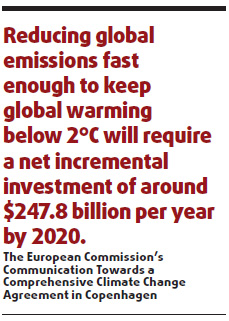

A number of leading scientists are calling for an up to 80 percent reduction in carbon dioxide emissions by 2050 to prevent rising temperatures that would change the climate and might fundamentally alter the planet.
Reaching this goal necessitates a transition to a low-carbon economy, which requires significant changes to the way we produce energy. Such changes call for significant investments in clean technologies.
Economists have projected global costs needed to facilitate this transition are from less than 1 percent to 5.5 percent of annual global GDP, while the costs of inaction are estimated to be between 5 percent and 20 percent of annual global GDP by 2050.
To put this in perspective, the International Monetary Fund expects that governments in G-20 countries will implement fiscal stimulus plans in response to the global economic downturn amounting to 2 percent of GDP in 2009 and 1.5 percent of GDP in 2010.
Given the uncertainty of private credit markets, risk aversion and capital shortages among financial institutions, most of the needed investment will come from governments in the short term to medium term.
But there is another means through which developers of clean technology can raise funds. This is through the sale of carbon offsets to companies committed to carbon neutrality.

According to the European Commission's Communication Towards a Comprehensive Climate Change Agreement in Copenhagen, which sets out conclusions adopted by EU Heads of Government at the Spring Council in March:
"Reducing global emissions fast enough to keep global warming below 2C will require a net incremental investment of around $247.8 billion per year by 2020, of which at least half ($123.9 billion) is needed in developing countries. One third of mitigation costs in developing countries could be covered by carbon markets."
A carbon neutral company is one that first and foremost commits to reducing its own carbon dioxide emissions produced through the energy it uses and business travel. The company then offsets its remaining CO2 emissions by purchasing carbon offsets from clean technology projects such as a wind farm.
A carbon offset represents one ton of CO2 not emitted into the atmosphere. For example, a wind farm supplies electricity to a power grid. That reduces the need for a coal-fired power station to burn as much coal, thereby avoiding CO2 emissions that would have otherwise occurred.
Through a certification plan like the United Nations Clean Development Mechanism (CDM), the wind farm converts the avoided CO2 into carbon offsets and sells them to carbon brokers or directly to carbon neutral companies.
HSBC became the world's first carbon neutral bank in 2005.
Carbon neutrality is part of HSBC's sustainability strategy and consists of three parts.
The first is measuring, managing and reducing its own CO2 emissions.
The second is purchasing "green electricity".
The third is offsetting the remaining emissions by purchasing carbon offsets.
For example, HSBC China replaced all the light bulbs in the bank's offices and branches in China with energy-saving light bulbs, which will save about 650,000 kWh of electricity per year, resulting in an annual reduction of CO2 emissions of more than 429 tons.
Since 2005, HSBC has purchased carbon offsets yearly to offset the CO2 emissions that remain after the bank has reduced energy consumption and business travel and purchased green electricity.
To become carbon neutral, HSBC purchases carbon offsets from certified projects around the world, including China, to offset the remaining CO2 emissions.
Take the example of a wind farm given above. According to the UN's CDM website, as of July 1, the majority of its wind energy projects were located in China.
China is taking a lead in wind power, recently increasing its goal of installed wind power to 100 gigawatts (GW) by 2020, which will make it one of the largest markets in the world. China is currently the fourth-largest market behind the United States, Germany and Spain.
Reaching this target will require large investments, some of which will come from the sale of carbon offsets to carbon neutral companies like HSBC. The bank currently holds over 1.3 million tons of offsets from clean technology projects in China.
This is equivalent to avoiding the carbon dioxide that would have been emitted from the annual electricity usage of more than 800,000 urban Chinese households.
One such project is a wind farm in northeastern China that reduces an average of 122,340 metric tons of CO2 equivalent per year.
Once certified as carbon offsets through the CDM, these offsets are available for sale on carbon markets around the globe. HSBC recently purchased 41,000 carbon offsets from this wind farm through a carbon broker.
The author is sustainability manager of HSBC Bank (China) Co Ltd's Group Communications. sector.
(China Daily 08/17/2009 page3)













